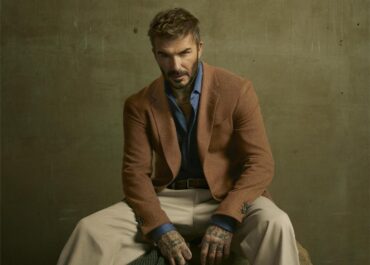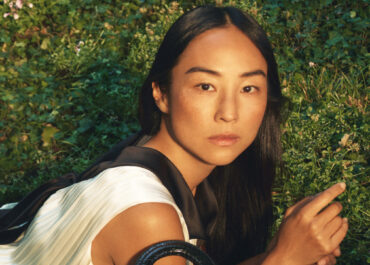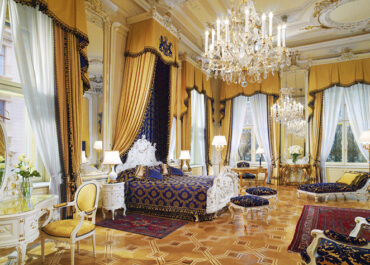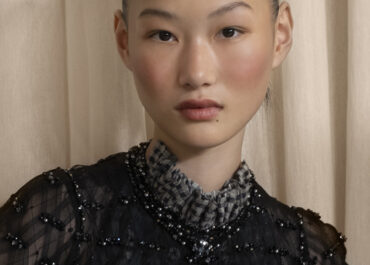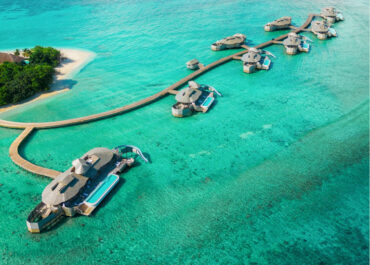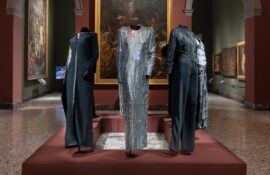Being an avid collector and a fan of Villeroy & Boch as a brand, the thought of visiting the splendid Baroque building of the “Old Abbey“ in Mettlach that houses the “Keravision“ exhibition where 266 years of Villeroy & Boch’s corporate history are displayed, always seem like a great plan to discover the latest novelties and re-live the success stories with a brand of such rich heritage and deep roots in the European culture.
During my visit I had the pleasure of meeting Nicholas Luc Villeroy, board member and CEO of the brand’s tableware division, where we had the following chat over dinner at the historic Schloss Saareck.

How would you describe Villeroy and Boch as a brand?
Not easy to sum up a 266 year old legacy but the story of Villeroy & Boch is very much linked to the European story.
If I look back in time, we have had an influence on the “eat and drink culture” since many years. We are a French- German company, and now German with roots in those 2 countries.
In the beginning, both families Villeroy & Boch where French. Boch moved to Luxembourg and afterwards to Mettlach where we have the headquarters today.
Villeroy started in France, they were both in competition. It was during the Napoleon era, the time of the continental blockade, goods produced in the United Kingdom where not allowed to be sold on the continent. In 1814 when Napoleon lost, the English goods started selling on the continent again.
In 1836, Villeroy & Boch merged together. Six years later, in 1842, my great aunt Octavie Villeroy married Eugine Boch. It was a consolidation from patrimonial union to matrimonial union. It was the base of deep roots. Those roots survived three French- German wars. They always had in mind the future of the company through hard times. This was the best example where the people can achieve when they start thinking in another direction. The French and the German today are the motor of Europe, and for Villeroy & Boch, it was always the case. We were the starters!
Two years ago they gave the peace Noble price to Europe. I was driving and heard it on the radio. I had tears in my eyes, and when people asked why I got so emotional when Europe imposes many laws, I said: I have another vision. In Europe, we have the biggest freedom period since the Romans! At a time where in many places around the world you have conflicts and wars, we have safety and stability!!

Tell us about the expansion of Villeroy & Boch?
I’m absolutely convinced that history and tradition are ways to breakthrough the future. If I look back in our history I can define three pillars that have been always there.
1) Tradition being a main pillar.
2) Diversification. We started with products for tableware and moved later toward sanitary ware and tiles.
3) Innovation. We always tried to innovate either in the design or the production process, since we wanted to make our products very high quality and affordable.
4) Internationalization. We started with two families: German and French with a base in Luxembourg, at a time where borders have always moved.
So we always had to adapt to new markets and seek new markets. Our mindset was always directed to export, from being present at the international fairs, to serving the Russian Tsar and Royalty around the world.
In the last period we decided to move abroad, one way with partners or agents or the other by moving directly with our regional offices.
We are in America, Australia, and Japan, moving to Asia where we have good sales in Korea, we are starting in Beijing and Shanghai in China, and we are opening in India.
Last but not least, we are present in the Middle East with more than 40 points of sales where a big part is with our distributor, Sara Trading.
We have the same type of movement for our bath and wellness division with one difference, which is the size, weight, and volume of the product. We can serve the world from our central warehouse in Mertzig for Tableware, but for bathroom and wellness we have additional factories, one in Mexico to cater for the USA, and one in Thailand to cater for Asia.
What are Villeory & Boch’s largest markets on the global level?
For the tableware division and on a global point of view, it is definitely Germany. Second comes France, followed by the USA.
If we want to measure it group- wise, Germany takes the lead, second comes the Nordic countries followed by France.
After Europe, we have many markets that are very big for us such as Japan, the Middle East and, Russia.
What is the customer looking for nowadays at Villeroy & Boch?
We are a brand that works with lifestyles. The essence of the brand is very much linked to where we come from, and to our tradition.
If you look outside you will see woods and fields and you will see a very old classical building. These inspire our two pillars of our lifestyles and offering: “The Country and The Classic”.
If we are at the modern cities, we evolve our design to meet the metropolitan lifestyle.
If we segment markets by taste: Europe is a market that has a high demand on both, the Country and Classic collections, while in the USA, the demand is on Country. The Middle East used to be very classic and now moving to contemporary.
Tell us about the design process at Villeroy & Boch and how you decide on what product you are going to offer the market?
There are basically two labels. The first is the classical product management where you analyze the product assortment you have and you identify the needs from the feedback that you get from the market. This is what I call the structured part of product development.
The second is where we have the design DNA and whether we should move more to Classic, Country, or Metropolitan.
How does it feel to be the heir of such an empire, and what are the 3 main messages you want transmit for generations to come?
I would probably tell them who we are, where we are coming from, and what are for me the 4 pillars we have at Villeroy & Boch. Tradition, Innovation, Diversification and Internationalization. Those pillars that were present over the centuries and should continue to be there.
There is one point that I may add and that would be Passion, which is considered the roof of this home. Since if you are not passionate about what you do, the burden will be too heavy. You have to face the responsibility of driving a business, the responsibility for your workers and your co-workers.
After 266 years the family is bigger, the shareholders are above 250 and the one big point that is very important is the need to be proud of the product your putting in the market, and that of course, is additional pressure when you run a family business.
You need to see yourself as a bridge between generations.
Besides having the passion, the main target that I would highlight will be: “you are becoming a heritage of the last 9 generations in a certain shape, your job is to transfer it into the coming generations in a better shape”.
What is an objective that you would still like to achieve?
I think we are always speaking about internationalization and being present globally. We are not global, yet are moving towards achieving it. This is part of the objective.
What is a personal favorite among the Villeroy & Boch collections?
To be honest I can’t name one. Since am in this business I always told the same story. Usually you can’t have breakfast, lunch, afternoon tea or dinner with the same person or with the same clothes, or at the same place. Why should you only stick to one set of porcelain?
I have many favourites for different occasions: French garden, New Wave, Old Luxembourg, Black Pearl, Indian Summer, My Wave from Paloma Picasso, Old Strasbourg and many more but never a complete set. I have a bit of everything.
What set you recommend for outdoors?
The next one will be released in February. We are bringing a new Anmut collection.
Is there any new collaboration with a designer after Paloma Picasso?
We have one in place now and that is with Isabelle de Borchgrave, the famous Belgian artist who used to work with Villeroy & Boch long time ago on tiles.
She worked on a project we had trying to mix the two faces of the brand.
The task was creating a pattern for our Artesano shape. And that was when she created the Artesano Provensal.
I have to say that this is not the usual way we work, since our philosophy is “Villeroy& Boch first” and sometimes when u work with external designers you need so much to market the designers more than the brand, so it’s a bit tricky.
Through our history you will always find collaboration with designers but not in a systematical way to develop products or concepts as some others do.
Tell us about brand’s social commitment. What are giving Europe?
We are really fighting for our environment.
I think that this is something that has always been part of our DNA at Villeroy & Boch.
We are the first producers moving from the wood-fire ovens to coal-fire ovens.
We have obliged ourselves to have our factory EMAS certified, which is the strongest environmental certification you can achieve for both of the ceramic factories. It obliges you to work with water consumption and what type of water you use .We are doing the same towards energy and we are having our factory ISO 50001 certified.
Our engagement is much more towards the planet. Why? Even if we are producing in the 21st century, we are producing with the help of the 4 elements. Fire, earth, water, air and we have to preserve them. This is part of our philosophy.

What is your insight on the post crisis economic situation and how do you forecast market recovery in Europe?
We have a diversified answer, since at this stage many markets in Europe still suffer and some are in good shape.
Germany currently is in good shape, the United Kingdom is evolving well, the Nordic countries are doing well, but in the South of Europe there are many countries that are still suffering with some evolution.
Spain hit the bottom but is rising up again, Italy as well. Portugal, Greece and France are still having big difficulties.
If I see the light at the end of the tunnel, it’s going to be quiet some more time. So it’s a mixed picture!
The difficulties will be trying to find a common goal and denominator in order not to segregate one country from another. Europe will only survive if there is unity.
Any plans of adding new product lines to the brand’s offering after Tableware and Bath & Wellness?
For the time being we don’t plan to add a third part of business. We still believe that there is a big potential in developing what we currently have. And what can we still achieve.
What is in the pipeline for the brand?
We are working on a lot of giftware concepts and in the direction of new place settings in tableware and glassware.






